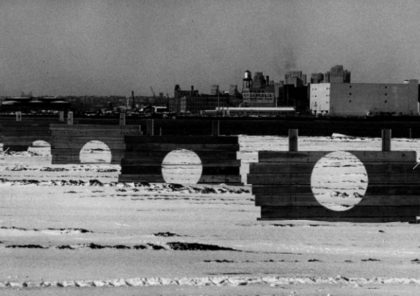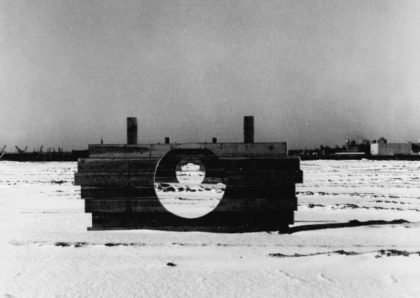Oral History: The Tribeca beach, circa 1977
In the mid ’70s, with the World Trade Center built and the fill deposited at what would become Battery Park City, the area west of Tribeca became a de facto beach. Locals used it to play as they did the condemned and abadoned Miller Highway, which before it was demolished, was claimed as an elevated cycling and jogging path.
Suellen Epstein, who has lived in the neighborhood for 45 years and teaches Children’s Tumbling in her Murray Street loft today, spent many a weekend day at the beach while it lasted. That’s her below in a photo (thanks to K. for the tip) that the Times recently ran along with other evocative shots taken by Fred Conrad in the summer of ’77.
“We didn’t have resources to go out to the Hamptons,” says Suellen, whose friends had already started to put down stakes out east. “We were out there on the beach any sunny Sunday – as long as it wasn’t wet. It was a great place to get through the whole Sunday times.”
It wasn’t the most luxurious sand, she said — it had gritty texture and of course was never washed by the ocean — but it got the job done. People came to sunbathe, play volleyball, read, relax. On the day the Times’ shot was taken, Suellen and her boyfriend had the expanse all to themselves. “You felt like you were not in the city –- like it was the Manhattan countryside.”
Around that time the public arts organization Creative Time was given a grant to install art on the beach, including the 1973 piece shown in the startlingly cool photographs above and below from local environmental artist Mary Miss. There were performances there too, back when, as Suellen notes, “lots of small dance companies were alive and well and people could afford to live as artists.”
Miss described her work this way: “Approaching the site from the north, the visitor saw nothing at first. Five insubstantial billboard-like structures were placed fifty feet apart across the site. As the viewer walked to the front of these plank walls, the project materialized: the unimposing structures held a series of clearly articulated concentric circles descending into the ground. It appeared as though a column of air was being defined as it tunneled into the ground; the circles are marking out the distance to materialize the space. All the bulk of a traditional monument or monolith had been cut away from this temporary work. The viewer was engaged in the making of the piece; movement was necessary for it to become visible.”
Excavators broke ground on the first residential building of Battery Park City in June 1980.
















This project was actually done in 1973 before Art on the Beach. It is on the same site that I did the South Cove installation in 1986.
Mary Miss, Just beautiful.
Site specific art that takes ones breath away.
All, please support funding for the arts.